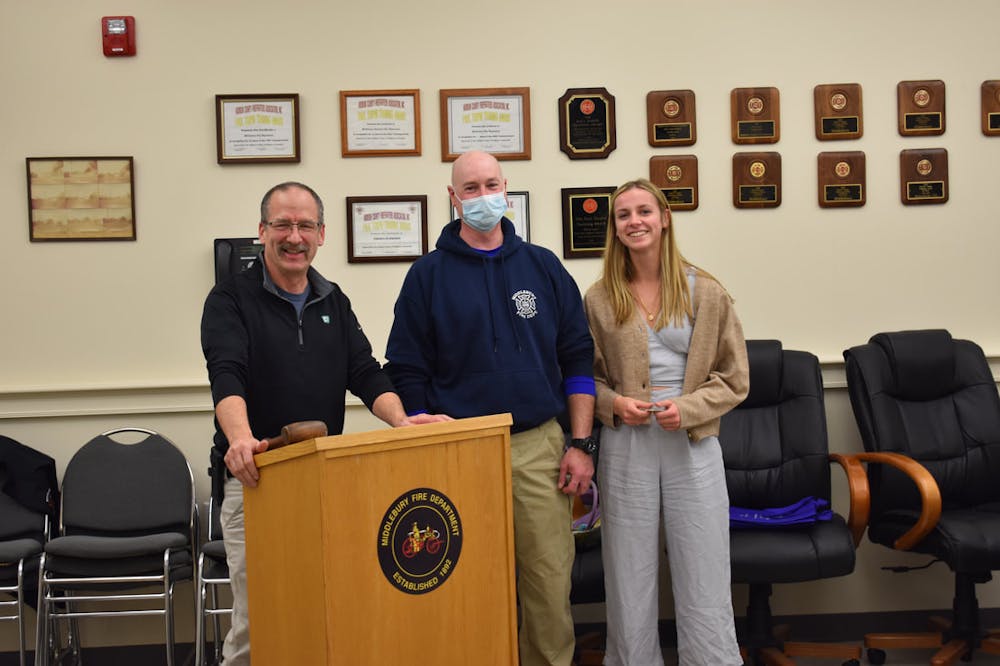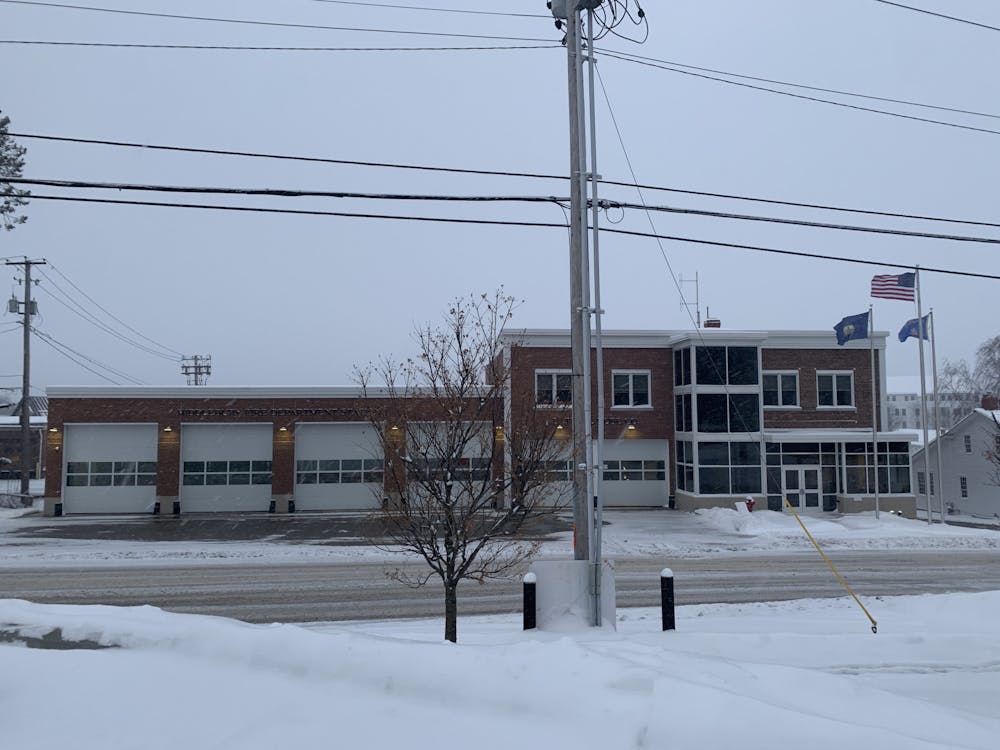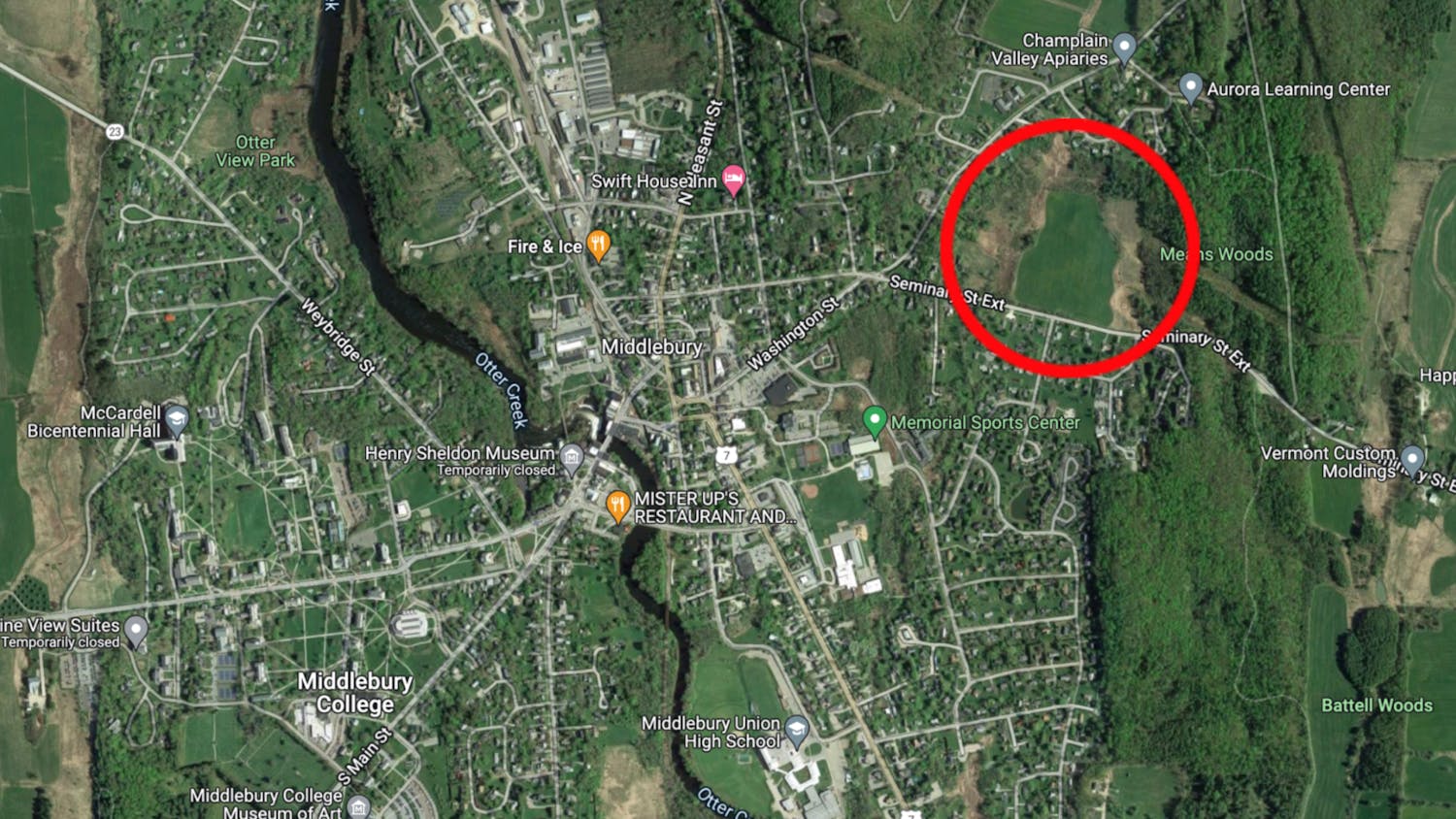It was an early fall morning, around 2:30 or 3 a.m., when the tones of a pager awoke Emily Jones ’23.
A car was burning next to a trailer in Middlebury. Firefighters were needed.
In her moonlit room, Jones spurred into action. She jumped out of her dorm bed, threw on a warm set of clothes, and buckled her bike helmet. She exited Starr Hall, climbed on her bike and raced to the station.
Jones arrived in time to make the first engine, riding aboard alongside other volunteer firefighters as they headed to the scene. There was no time to yawn.
By the time Jones and the other firefighters had finished extinguishing the fire and returned to the station, the sun was gently rising over the Green Mountains. Jones pedaled back to campus, tired and sweaty from her efforts, desperate to get a few more hours of sleep before class later in the morning.
This academic year, Jones is one of six Middlebury students who are probationary firefighters at the Middlebury Fire Department (MFD). These students are on call 24/7 for the entire academic year, working alongside about 30 other volunteers at the station. But what does this commitment actually look like? Why do students volunteer at MFD? And what do they get out of the experience?
Recruitment and commitments
The relationship between MFD and the college dates back to 1988, when Dillon Dimick ’92 joined the department as a probationary firefighter. Since then, 34 other students have volunteered at the department, with six students currently in the process of becoming full-time members: Emily Jones ’23, Ben Arriola ’23, A.J. Rossbach ’23.5, Luke Van Horn ’23.5, Eli DiBari ’24 and Conrad Kang ’24.5.
Student recruitment is a thorough process. When students express interest in volunteering, whether via the department’s website or at the student activities fair, they are asked to complete an application and are vetted by the department. The number of student volunteers is limited to seven — the department doesn’t want a big void in membership when students graduate — so spots are competitive.
“We want to make sure they really fit with us,” MFD Chief David Shaw told The Campus. “We don’t have time for people who think this is really cool but don’t want to actually do anything. For us, it’s not a game, it’s a business, we’re providing public safety to taxpayers who pay a lot of money.”
Shaw added that the department specifically seeks type-A personalities. They want eager, action-oriented students who have a passion for service. “When you look at the [six Middlebury students] we have now, the common theme is, ‘What can we do to help out?’ It’s about service before self,” Shaw added.
Once students successfully navigate the recruitment process, they enroll in the mandatory Firefighter One certification course, which teaches the necessary skills of being an interior firefighter, the type of firefighter that enters buildings. The course is rigorous, spanning about 200 hours in length, beginning in September and ending in May.

Outside of lectures, students take exams, attend departmental meetings and complete training sessions at Middlebury’s station and at the Vermont Fire Academy in Pittsford. In a given week, students may have a departmental meeting on Wednesday, Firefighter One class on Thursday night and a day-long training session in Pittsford on Saturday.
“It’s a wicked, rugged grind for students,” Chief Shaw said. “They learn all the basics of firefighting when they graduate.”
There is also an emphasis on hands-on experience for student firefighters, who are given a pager and encouraged to assist with calls when they can. MFD responds to about 200 calls a year, including house fires, car accidents and hazardous material incidents.
Chief Shaw acknowledged the significant commitment for probationary firefighters, noting that academics take priority.
“The number one reason they’re in Middlebury is because they’re college students. Their goal and their parents' goal is for them to have a degree when they leave — and that’s our goal, as well,” he said. “We as a fire department don’t want to compromise this. We’re always asking them how class is going. If you have a test or final, that’s where you should be.”
By late May, probationary members conclude their training with final written and practical tests. If they pass, they are officially interior firefighters and receive a ceremonial introduction to the department.
Finding a community, learning new skills
While some students find their niche at the college, whether that be a varsity team, a club, or a special interest group, others may long for a different experience. The fire department is unlike any student organization on campus, differing in its demographic, activities and expectations.
Jeff Carpenter, the chair of the Economics department at Middlebury and a captain at MFD since 2017, said that some students are drawn to firefighting because it’s a change of pace from student organizations.
“There is no flaking out… there are consequences at the firehouse that aren’t on the hill,” Carpenter said. “There are no excuses, no ‘I’ll do it later.’ Taking this class makes you even more cognizant about time management.”
Working for MFD can also strengthen a students’ connection to the town. When responding to calls and interacting with other volunteer firefighters, students are introduced to community members that they might otherwise never meet. “A common theme is that students wanted to get off the hill and experience what a small town in Vermont is really like,” Chief Shaw said.
Jones has now been volunteering at MFD since September and has already felt a heightened connection to the community.
“Joining fire was about committing myself to something that felt larger than Middlebury and this campus — and I think it’s done that for me in a huge way,” Jones said. “It’s an enormous privilege to know Middlebury as I know it now. That feels really important to me.”

Eli DiBari ’24, one of the probationary firefighters, echoed this sentiment.
“It’s cool to work with people who have lived in Middlebury their whole lives and really enjoy the service,” DiBari said. “It’s also a unique opportunity to connect to the community that most students don’t have.”
Last but not least, working as a firefighter gives students the chance to learn skills that might not be taught in a classroom at Middlebury.

Eli DiBari ’24 completes search and rescue training during a Firefighter One exercise at the Vermont Fire Academy on Saturday, March 26.
“Working as a firefighter has taught me a lot of real-life skills that transcend firefighting,” DiBari said. “Knot-tying, dynamics of fire, building construction — cool things that round out my greater knowledge of the real world. Everyone who works at the fire department at Middlebury has a wide range of interests and skills and I find myself learning things from them constantly.”
Mutually beneficial relationship
Having a partnership with the college makes MFD unique when compared to other fire departments. Chief Shaw noted that there are countless benefits to this distinctiveness. For instance, student firefighters are always asking questions, often sparking change and innovation at the station.
“Every once in a while, we wonder, ‘Well why do we do this?’ They challenge the way we do business, and by challenging us, it makes us a better department,” Shaw said.
Carpenter added that the student firefighters bring unique personalities to the department. “For us, it’s nice to have the young blood, too. They keep us young. They’re fun to be around,” he said.
For many student probationary firefighters, this commitment is the first of many in the world of public service. Chief Shaw has a certain pride in the number of former students who have gone on to pursue a career in firefighting after MFD. Alex Browne ’18, who became a firefighter in Colorado after graduating from Middlebury, is one example.
Above all, there is an emphasis on family at MFD. Students and locals are brought together in a novel way, strengthening the college-town relationship. And even when student firefighters graduate, these relationships persist.
“Fire service is really about family; it’s an old cliche, but it’s 100% true,” Chief Shaw said. “You really make connections with members, so it’s not just walking away. We’ve put roofs on members’ houses, we’ve gone to college graduations. I’ve met more college parents and made more long term relationships with college students through this program than I could ever imagine.”
Emily Jones ’23 is a sports editor for The Campus.

Blaise Siefer ‘23.5 is a sports staff writer.
Siefer is majoring in Sociology and minoring in Spanish.
For three semesters in 2021 and 2022, Siefer served as Senior Sports Editor. He also co-founded a Middlebury sports recap podcast, PFL Weekly, which is released on all major streaming platforms every Tuesday.
Siefer is also the Co-Founder and Co-President of Middlebury Club Soccer.




